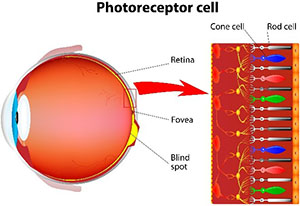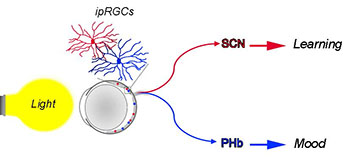Archived Content
The National Institute of Mental Health archives materials that are over 4 years old and no longer being updated. The content on this page is provided for historical reference purposes only and may not reflect current knowledge or information.
The Pathways Through which Light Affects Learning and Mood
Study uncovers distinct retina-brain pathways
• Science Update
Research has shown that light is important for more than just vision—it directly impacts mood and learning. In a new study, researchers at the National Institute of Mental Health (NIMH) traced the brain pathways responsible for the effects of light on learning and mood. The findings revealed that these effects are brought about by two different and distinct pathways from the retina into the brain. One of these pathways includes a previously unrecognized cluster of neurons (called a nucleus) in the thalamus, a part of the brain responsible for relaying sensory information to other brain areas.
“This work finally assigns a brain region where light can have an impact on mood, providing evidence for the positive effects of light therapy in treating depression in humans,” said Samer Hattar, Ph.D., study author and chief of the Section on Light and Circadian Rhythm at the NIMH.

eye. Credit: iStock.com/ttsz
In mammals, light is detected in the retina by several types of sensory cells called photoreceptors. The most commonly recognized photoreceptors are called rods and cones. But in addition to these, there are a group of cells called intrinsically photosensitive retinal ganglion cells (ipRGCs) that are naturally sensitive to—and can detect—light. Neural connections from ipRGCs provide information used in non-image-forming visual functions such as those involved in circadian photoentrainment (the training of an animal’s internal bodily clock and biological processes to correspond with light and dark periods) and sleep regulation.
While researchers discovered in 2012 that the effects of light on learning and mood begin in the retina with ipRGCs, nothing was known about the brain pathways through which these effects occur. In this study, the researchers sought to gain a better understanding of the brain pathways, beginning with ipRGCs, that lead to the effects of light on learning and mood. One major area ipRGCs project to is a part of the brain called the suprachiasmatic nucleus (SCN), which houses a central pacemaker that coordinates circadian-related functions across the body. Therefore, researchers were interested in studying this structure as part of their investigation of these retina-brain pathways, since, according to Dr. Hattar, “previous studies have shown that the SCN can have a major impact on learning as well as other functions.”
The researchers examined mice that were genetically altered so that the ipRGCs that stimulate the SCN survive, but those that project to places outside the SCN do not. The researchers exposed these mice and typically developing unaltered mice to normal light and dark cycles or to abnormal light and dark cycles. The mice were then tested on several tasks that model learning and cognitive functions and mood.
Distinct pathways for light’s effect on learning and mood
When the researchers looked at learning and cognition in the mice, they found that both the unaltered mice and the genetically altered mice showed normal behaviors in the normal light condition and abnormal behaviors in the abnormal light condition. These findings suggest that the pathways that lead from ipRGCs to the SCN are sufficient for light to impact learning and cognition.
When the researchers looked at mood responses in the animals, they found that both unaltered mice and the genetically altered mice showed no differences in mood responses when exposed to the normal light condition; however, when these mice were exposed to the abnormal light condition, the unaltered animals showed altered mood responses, whereas genetically altered animals did not. These findings suggest that pathways from the ipRGC to areas outside of the SCN are required for driving light-based regulation of mood.
The perihabenular region as part of the light-mood pathway
The researchers then worked to identify the brain pathways outside of the SCN that are responsible for the effect of light on mood. They focused on a region of dorsal thalamus—an area which was previously termed the perihabenular region (PHb). This area has been shown to receive information from the retina and to contain a circadian clock. The researchers found that connections from the retina to the PHb are exclusively made up of ipRGCs.

They also found that the PHb connects to parts of the prefrontal cortex, involved in mood regulation, and to other brain areas involved in affective-emotional processing. Remarkably, chronically activating the PHb in animals living under normal light conditions induced mood alterations, while inhibiting this region in animals living under abnormal light conditions blunted the mood changes. The findings identify this area in the thalamus as a newly recognized light-dependent mood center that is specific for light input from ipRGCs.
“Previously, it was thought that changes in mood associated with alterations in daylength preceded learning problems,” said Dr. Hattar. “Here we show that learning and mood changes in response to light require completely distinct retina-brain circuits in rodents and that there is a dedicated thalamic area that mediates the effects of light on mood.”
To learn more, view a story about this study published online by the journal Cell.
Reference
Fernandez et al., Light Affects Mood and Learning through Distinct Retina-Brain Pathways, Cell (2018), https://doi.org/10.1016/j.cell.2018.08.004
